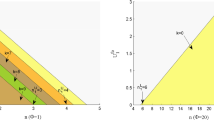Abstract
In this paper, strategic behavior of passengers in a batch transfer queuing system with gated policy under complete information is investigated. Two solutions are used to solve the stationary distribution of the system. Particularly, suppose that arriving passengers have the opportunity to observe all information of the system upon arrival, we derive equilibrium joining strategy of passengers under this information when passengers fall into the dilemma of joining or balking. We prove that the equilibrium joining strategy is a threshold type, but when some parameters change, it may be changed. Under the equilibrium strategy of threshold type of the observable case, we give the parameterized expected total net social benefit function. Finally, a number of numerical experiments on equilibrium social benefit with respect to several parameters are presented, which are used to explore the theoretical results of the system and compare observable case and unobservable case of the system.
Similar content being viewed by others
References
Antonis E, Athanasia M (2013) Equilibrium balking strategies for a clearing queueing system in;alternating environment. Ann Oper Res 208(1):489–514
Bountali O, Economou A (2017a) Equilibrium joining strategies in batch service queueing systems. Eur J Oper Res 260:1142–1151
Bountali O, Economou A (2017b) Equilibrium threshold joining strategies in partially observable batch service queueing systems. Ann Oper Res 230:1–23
Chen J, Huang S, Hassin R, Zhang N (2015) Two backorder compensation mechanisms in inventory systems with impatient customers. Prod Oper Manag 24 (10):1640–1656
Choudhury G, Madan KC (2017) A batch arrival Bernoulli vacation queue with a random setup time under restricted admissibility policy. International Journal of Operational Research 2(1):81–97
Dimitrakopoulos Y, Burnetas AN (2016) Customer equilibrium and optimal strategies in an M/M/1 queue with dynamic service control. Eur J Oper Res 252 (2):477–486
Economou A, Kanta S (2008) Optimal balking strategies and pricing for the single server Markovian queue with compartmented waiting space. Queueing Systems 59(3):237–269
Edelson NM, Hilderbrand DK (1975) Congestion tolls for poisson queuing processes. Econometrica 43(1):81–92
Hassin R (2016) Rational queueing. CRC Press, Boca Raton
Hassin R, Haviv M (2003) To queue or not to queue: equilibrium behavior in queueing systems. Kluwer, Boston
Haviv M (2013) Queues-A course in queueing theory. Springer, New York
Manou A, Economou A, Karaesmen F (2014) Strategic customers in a transportation station: when is it optimal to wait? Oper Res 62(4):910–925
Naor P (1969) The regulation of queue size by levying tolls. Econometrica 37 (1):15–24
Neuts MF (1984) Matrix-geometric solutions to stochastic models. Springer, Berlin
Shaler SJ (2009) Optimal design of queueing systems. CRC Press, Boca Raton
Shi Y, Lian Z (2016) Optimization and strategic behavior in a passenger-taxi service system. Eur J Oper Res 249(3):1024–1032
Wolff RW (1989) Stochastic modeling and the theory of queues. Prentice Hall, New Jersey
Wong RCP, Szeto WY, Wong SC (2014) Bi-level decisions of vacant taxi drivers traveling towards taxi stands in customer-search: Modeling methodology and policy implications. Transp Policy 33(2):73–81
Ye Q, Liu L (2015) The analysis of the M/M/1 queue with two vacation policies (m/m/1/SWV+MV). Int J Comput Math 94(1):115–134
Ziani S, Rahmoune F, Radjef MS (2015) Customers strategic behavior in batch arrivals M2/M/1 queue. Eur J Oper Res 247(3):895–903
Acknowledgements
We are grateful to the anonymous referees and editors for their constructive comments and feedback that help us to improve the presentation and quality of this manuscript. This work is supported by The National Natural Science Foundation of China (No. 61773014), the Research Fund for the Postgraduate Research and Practice Innovation Program of Jiangsu Province (No. KYCX18_0373).
Author information
Authors and Affiliations
Corresponding authors
Rights and permissions
About this article
Cite this article
Wang, Z., Liu, L., Shao, Y. et al. Equilibrium Joining Strategy in a Batch Transfer Queuing System with Gated Policy. Methodol Comput Appl Probab 22, 75–99 (2020). https://doi.org/10.1007/s11009-018-9687-3
Received:
Revised:
Accepted:
Published:
Issue Date:
DOI: https://doi.org/10.1007/s11009-018-9687-3




